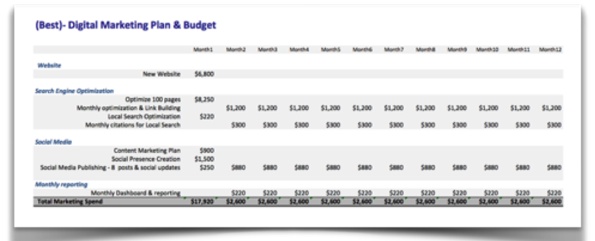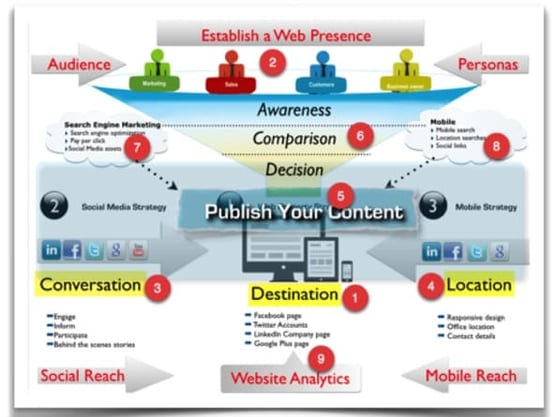Welcome business owners, marketers and esteemed WSI digital marketing blog readers! My name is Francois Muscat and I'll be your host for WSI's upcoming Digital Power Hour webinar How Playing the Comparison Game Can Gain You A Competitive Advantage. I'm going to dive right into some of the topics I'll discuss in next week's webinar in hopes that you'll join me for the session!
Benchmarking Against Competitors
Do you know how well your online presence performs against your competitors? Whether you are competing on the sports field or in business, you need to know how you compare against your peers.
You need this information if you want to be “best of breed” in your industry and want a baseline on which to benchmark your performance against.
Benchmarking can provide you with insights as to what your customers are experiencing when they visit your site versus your competitors. Benchmarking also gives you vital information that can be used to refresh your website or rethink your search, social and content marketing strategies.
First Things First - Build A Web Presence
It's no use building a basic 5-page website if you hope to compete in today's digital landscape. You need a top notch digital footprint in order to effectively execute high-level digital marketing tactics. At minimum, you should have a responsive site, active social media profiles and a blog that acts as the central hub for your content marketing activities.
Here is a graphic that I use to show what a complete web presence consists of and how it all hangs together:
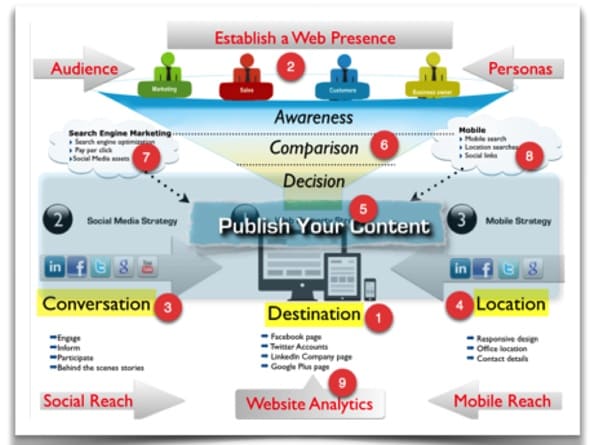
#1 - Create your main web properties so that you take up at least the first 5 entries of Google for your name. I call this the “destination” where visitors are expected to be sent to.
#2 - Identify your "personas” and build the website for them. Planning your content and navigation for your audience will improve website conversion.
#3 - Create and engage on social media profiles that your “personas” are on. I call this the “conversation”. All conversations should lead to the “destination” - that means when you write a status update on social media, ask yourself one question: “what do I want the reader to do after they have read my post?”
It's important that you add a link to further information on your blog or website. That way you generate website traffic, which is one of the main goals of having a website. Every social media update that generates a visitor can be allocated the same value as if you paid Google for a click using AdWords. That starts to give you measurable ROI for social media.
This is where we educate and engage in conversations with our audience. We build a “social reach” which means we have the ability to message our community quite easily with a few clicks. Look at your social reach as your community. If you don’t build a community and your competitors do - then you will be at a serious disadvantage when you realize you have catch up to and that you are two years behind.
#4 - Mobile strategy, which is what I call this your “location.” Mobile search has started to overtake desktop search and the main reason for this is that people are looking for local information. So keep this in mind and create locally optimized content that displays well on a mobile device. If you run a separate mobile site, then make sure that you include links to your main site, which is your “destination.”
#5 - Now that you have built all your web properties, the stage is set for your content marketing. Plan your content calendar around themes and topics that are relevant to your target personas. It's time to start thinking like a publisher.
#6 - Write your content for your marketing funnel. Think in terms of your audience's awareness, their tendency to compare and the fact that they ultimately have to make a decision.
#7 - Now you will start getting search engine visibility from your content on your web properties.
#8 - Your content starts to get displayed on mobile devices because of local search content.
#9 - Finally, how do you know if any of this is working? Install and analyze your Google Analytics to find out where most of your traffic is originating from and whether your social activities are starting to pay off.
Identifying Your Competitors
I like to choose five competitors to benchmark against. The best is to select three to four competitors that you run up against every day and then add one that is a world-class best practice site in your industry. That way we get a good cross reference view of how well your main competition is doing and also what the best-in-class do. We learn a lot from this exercise.
The next step is to analyze each competitor on the following online marketing tactics:
Website Review - WSI has a great website audit tool called WebScan that quickly identifies weak points in your website against a number of criteria.
Search Visibility - We uncover how many keywords your competitors rank for in the top 20 results in Google. This shows us keyword phrases that you might never have thought of. I will be talking about these tools in the upcoming webinar, so be sure to attend if you want to find out how we do this. Then we uncover the Google AdWords keywords and ad copy if they have engaged in a PPC campaign.
Content Audit - We review the competitors' blog posts and landing page content to find out what they publish online that gets search traffic and long tail keyword results in Google.
Social Media Activity - in this section of the report we detail which social networks each competitor is present on. Then we review their activity and engagement to learn where they are having success. The one tool that I will show you very quickly reports on the most shared content of you competitor. Knowing this information is invaluable as you quickly identify the content themes that are shared in your industry. This is vital input into your strategy.
Social Media Activity - Next we present a one-page dashboard that shows you exactly how you are positioned against all the competitors and we can quickly plan activities that will get quick results within a reasonable budget. The dashboard below was prepared for a client who wanted to find out what it would take to start up an online cigar store. We reviewed the top sites and identified what each site did based on our measurement criteria.
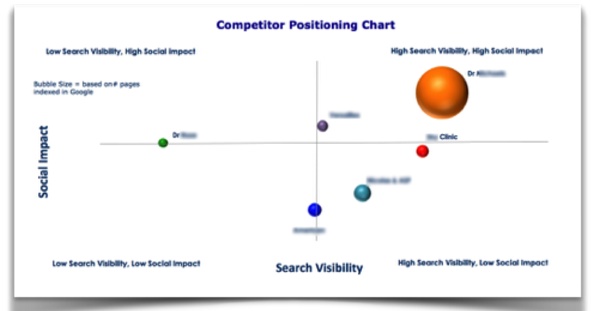
We looked at search visibility along the “X axis” and take into account the keywords used in both paid and organic search and the search volume and position of each keyword phrase.
The same applies for social activity and presence. Along the “Y axis” we compare the size of each social network and the engagement activity of each competitor.
The size of the bubble is related to the amount of content the site has. Normally lots of content that is well optimized and shared on social networks results in the best performance on search as well as social networks.
Here is a competitor analysis where we compared our client against their top five dentist competitors.
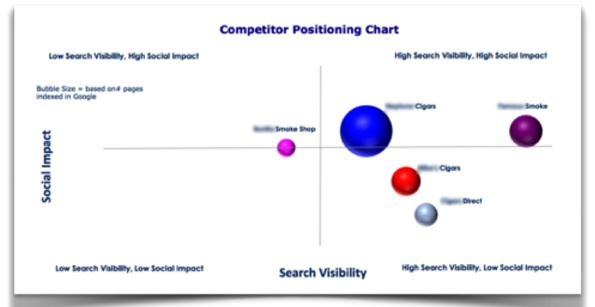
Our client, the green bubble, is way behind his competitors. The orange bubble shows that this competitor has more content than the rest and it is well optimized as we found out from reviewing their top 20 organic search results in Google. They publish this content on social networks, which increases their engagement and search results.
Working Out The Plan and Budget
We plan 3 budgets, good, better and best. This helps the client to decide how much they can afford and where to prioritize their digital budget for the best results. To find out more on analyzing your competitors, register for our webinar on Tuesday, February 24 at 11am EST!
